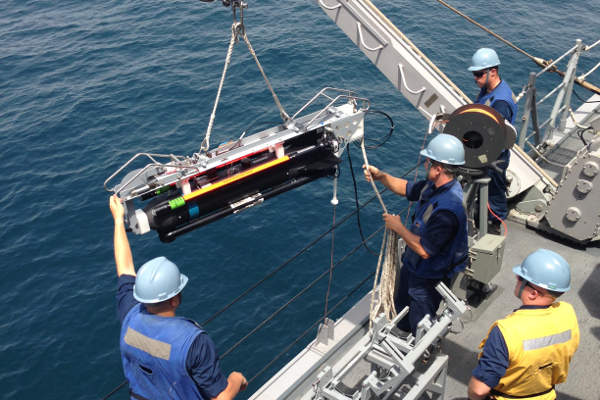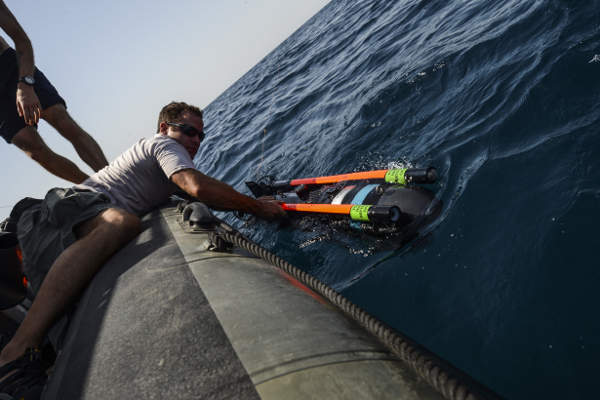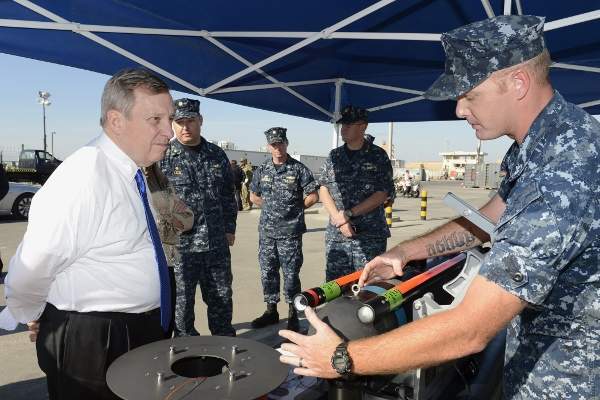The Seafox is a mine disposal unmanned underwater vehicle (UUV) manufactured by Atlas Elektronik. The UUV was developed based on the expendable mine disposal vehicle (EMDV) principle.
The semi-automatic UUV is primarily used for the disposal of mines and other identified ordnance in sea. It can detect and classify the mines and sea objects. It is guided by a fibre-optic cable.
The SeaFox can also be used in damage estimation, intelligence, route survey, maritime boundary control and harbour surveillance missions.
The complete SeaFox system includes a console, a launcher, and the SeaFox vehicles. It can be launched from a range of naval platforms such as dedicated mine counter measures vessels (MCM), surface combatants, rubber boats and helicopters.
SeaFox system orders and deliveries
The UK Ministry of Defence awarded a contract to Ultra Electronics and ATLAS in January 2006 to procure SeaFox UUV for the Royal Navy’s Hunt class and Sandown class MCM vessels. The UUV is currently in service in more than ten countries.
The Royal Thai Navy (RTN) placed an order with Atlas Elektronik in December 2011 for three SeaFox mine disposal UUVs.
The US Navy placed a contract with Lockheed Martin in February 2012 to adapt SeaFox UUV system for its MH-53E Dragon mine hunting helicopter and the Avenger-class MCM vessel.
The US Naval Surface Weapons Centre (NSWC) awarded a contract for additional SeaFox vehicles to support its Surface Mine Neutralisation System (SMNS), in October 2012. The SeaFox UUVs were deployed by the US Navy in the Persian Gulf in 2012 to clear the mines.
SeaFox UUV variants
SeaFox is mainly offered in four variants to meet the different mission requirements of users. The variants include SeaFox C, Sea Fox I, SeaFox T and SeaFox COBRA.
The SeaFox C is a one-shot mine identification and disposal vehicle system used as a tool to semi-automatically dispose mines and other related things found in the sea. It can quickly relocate the identified objects using onboard homing sonar. Once relocated, these objects are destroyed using an inbuilt, large calibre-shaped charge of the vehicle. The vehicle is powered by a non-rechargeable LiSO2 battery.
Sea Fox I is a mine identification, inspection and training UUV. It is a reusable vehicle, which can be used to identify the mines and train the field staff. It is fitted with a ballast weight instead of a warhead.
SeaFox T is a training version of the SeaFox C. It is intended to train onboard naval crew members to operate the SeaFox C.
SeaFox COBRA is equipped with the COBRA explosive ordnance disposal (EOD) tool supplied by ECS Special Projects. The vehicle has a remote RF-coded initiation capability with a range of up to 1.5km for commercial use and up to 22km for military use. The target is attached to the vehicle in three ways, which include nail attachment units, harpoon for soft-skinned targets and magnetic grabs.
Design features of SeaFox
All the variants of the SeaFox UUV have a similar physical design and dimensions. The UUV has an overall length of 1.31m and width of 0.39m. It is designed with a height of 0.39m, and weighs approximately 43kg.
The UUV can be operated at a depth of up to 300m. It can operate at a maximum speed of 6kt. It has a maximum endurance of 100 minutes depending on the assignment and other conditions.
Navigation and sensor system for the SeaFox mine disposal system
The SeaFox mine disposal systemuses transponder/responder aided dead reckoning (pressure sensor) for navigation in the sea. The operator communicates with the SeaFox using a fibre-optic cable.
The SeaFox is equipped with FLS sensors and a TV camera to identify the target and acquire related information.
SeaFox propulsion and power
The vehicle includes four independent reversible motors and a hover thruster which provides high manoeuvrability in reaching the desired position.
Both SeaFox C and SeaFox COBRA are powered by non-rechargeable LiSO2 battery, while Sea Fox I and SeaFox T variants use rechargeable NiMH batteries.
Related content
Remus-100 Automatic Underwater Vehicle, Norway
Remote Environmental Measuring Units (REMUS)-100 are light and compact AUVs (Automatic Underwater Vehicles) designed by the Woods Hole Oceanographic Institution (WHOI).
HSV-2 Swift (High Speed Vehicle), United States of America
The HSV-2 Swift (HSV 2) is a chartered high-speed vessel of the US Navy Military Sealift Command





.gif)